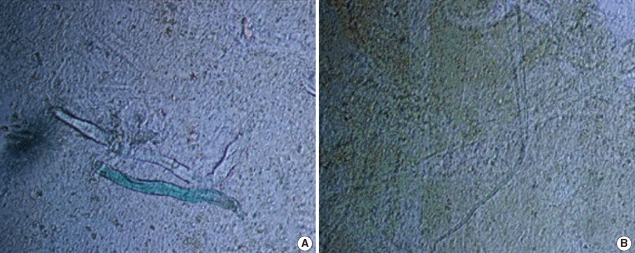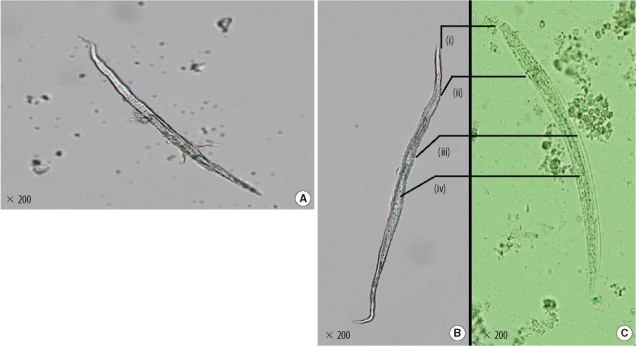Korean J Lab Med.
2011 Jan;31(1):44-46. 10.3343/kjlm.2011.31.1.44.
Plant Root Hair in Tap Water: A Potential Cause for Diagnostic Confusion
- Affiliations
-
- 1Department of Microbiology, the Aga Khan University Hospital, Karachi, Pakistan. sadia.shakkoor@aku.edu
- 2Department of Medicine, the Aga Khan University Hospital, Karachi, Pakistan.
- KMID: 1096659
- DOI: http://doi.org/10.3343/kjlm.2011.31.1.44
Abstract
- Plant root hairs are commonly found artifacts in parasitology specimens and may be confused with helminthes by an untrained eye. We report a case of brain tuberculoma where the tissue sample was contaminated with root hair derived from tap water; the presence of this root hair, which mimicked a larva, led to diagnostic confusion. Therefore, tap water should be considered a source of root hair and vegetable matter.
Keyword
MeSH Terms
Figure
Reference
-
1. Paul Y. Undigested food presenting as bizarre objects in stool. Indian Pediatr. 1994; 31:1130–1131. PMID: 7883378.2. Martínez-Girón R, González-López JR, Esteban JG, García-Miralles MT, Alvarez-de-los-Heros C, Ribas-Barceló A. Worm-like artifacts in exfoliative cytology. Diagn Cytopathol. 2006; 34:636–639. PMID: 16900479.
Article3. Isenberg HD, editor. Clinical microbiology procedures handbook. 2004. 2nd ed. Washington DC: ASM Press.4. Garcia LS, Bruckner DA, editors. Diagnostic medical parasitology. 1997. 3rd ed. Washington DC: ASM Press;p. 749.
- Full Text Links
- Actions
-
Cited
- CITED
-
- Close
- Share
- Similar articles
-
- The role of domestic tap water in Acanthamoeba contamination in contact lens storage cases in Korea
- Mutagenic Activity of Organic Pollutans in Drinking Water in Seoul
- Quality and risk assessment of lead and cadmium in drinking water for child development centres use in Phatthalung province, Thailand
- Risk Assessment of Lead and Cadmium in Drinking Water for School use in Nakhon Si Thammarat Province, Thailand
- The Effect of Ingesting Small and Large Amount of Tap or Iced Water on Circulation of Normal Men



